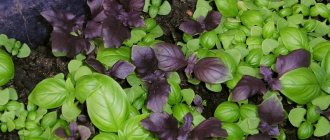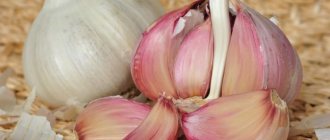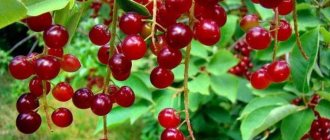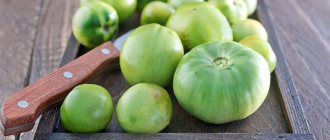Dried basil is an aromatic spice that has unique beneficial properties and adds a rich taste to the dish. Initially, this herb was widely used in French, Greek, Italian, Georgian and Azerbaijani cuisine.
The popularity of the seasoning grew rapidly, and soon it became an element of the culinary culture of other peoples. However, the fresh leaves of the plant quickly deteriorated, and cooks began to look for a way to increase the shelf life of the spice. Drying basil made it possible to prevent the loss of beneficial and taste properties, as well as to prepare the seasoning for future use.
Composition and beneficial properties
Basil contains many beneficial substances:
- beta-carotene is an antioxidant that reduces the risk of colds and infectious diseases;
- fiber - regulates digestion, cleanses the gastrointestinal tract of waste and toxins, reduces cholesterol levels;
- essential oils - prevent skin aging, normalize water-salt balance in the body;
- carbohydrates - provide the body with energy;
- rutin - strengthens the walls of blood vessels, prevents the risk of thrombosis;
- tannin - normalizes blood clotting, eliminates inflammatory processes on the skin and prevents intestinal disorders;
- flavonoids - normalize metabolism, prevent the development of malignant tumors;
- vitamin A (retinol) is an antioxidant, restores epithelial tissue and vision, normalizes the production of growth hormone: somatotropin, improves immunity;
- B1 (thiamine) - promotes the absorption of proteins, fats and carbohydrates, participates in the regulation of the cardiovascular, nervous and digestive systems;
- B2 (riboflavin) - ensures a healthy appearance of the skin and regulates the functioning of the thyroid gland and liver, participates in the process of hematopoiesis;
- B3 (pantothenic acid) - regulates the functioning of the adrenal glands and the synthesis of antibodies;
- B4 (choline) - improves memory, increases insulin production, regulates the functioning of the nervous system and fat metabolism;
- B5 or PP (nicotinic acid) - prevents diseases such as: dermatitis, diarrhea, dementia;
- B6 (pyridoxine) - produces hemoglobin and supplies cells with glucose;
- B9 (folic acid) - prevents the development of anemia, participates in the metabolism of proteins and amino acids;
- vitamin E (tocopherol) - an immunomodulator and antioxidant, prevents the aging process, stimulates muscle activity and the function of the gonads;
- vitamin K (phylloquinone) - prevents bone deformation, regulates metabolism, hematopoietic processes and the state of the immune system;
- vitamin C (ascorbic acid) - participates in the formation of collagen, the synthesis of neurotransmitters and thyroid hormones;
- calcium - improves the condition of bones, tooth enamel, participates in blood clotting and muscle contraction;
- potassium - regulates the rhythm of heart contractions;
- sodium - regulates cardiac function, prevents excessive sweating;
- phosphorus - increases the strength of bone tissue, without it mental and physical activity is impossible;
- iron - participates in hematopoiesis processes, iron ions are part of hemoglobin;
- zinc - improves the functioning of the immune and digestive systems;
- manganese - takes part in all processes occurring in the body. It is involved in the formation of enzymes and is also necessary for brain activity and the functioning of the nervous system;
- copper - participates in hematopoiesis processes;
- selenium - prevents the development of cancer.
There are 251 kcal per 100 grams of dried basil, of which:
- proteins - 14.4 g (57.6 kcal);
- fat - 4 g (36 kcal);
- carbohydrates - 61 g (244 kcal).
Energy value (used) - 22%/14%/97%.
How is it different from fresh?
Basil does not change its qualities when dried, unlike many other spices. When dried, it does not lose its unique taste, the aroma also does not change and even slightly intensifies.
Dried basil fully retains its beneficial properties and is not inferior to fresh in terms of vitamins and microelements. The only vitamin whose content is reduced is vitamin C.
Calorie content of dried basil is 230 kcal. per 100 grams, of which:
- proteins 22.98 g;
- fats 4.07 g;
- carbohydrates 47.75 g.
Content of macroelements, each of which is necessary for the human body, per 100 g:
- potassium – 2630 mg;
- calcium – 2240 mg;
- magnesium – 711 mg;
- sodium – 76 mg;
- phosphorus – 274 mg.
Microelements content:
- iron – 89.8 mg;
- manganese – 9.8 mg;
- copper – 2100 mcg;
- selenium – 3 mcg;
- zinc 7.1 mg.
How to use and where to add
Basil is mainly used in cooking. Can be used as an independent seasoning, for example, in combination with cheese or tomatoes. This green is also included in a mixture of Provençal and Italian herbs. In addition to cooking, it is used in folk medicine for medicinal purposes.
Use in cooking
Basil combines bitter notes and astringency in its taste. It is used in preparing Italian dishes.
It goes well with fish and meat dishes. Greens are added to pastas, salads, sauces, soups, omelettes, risotto, stewed vegetables, winter preparations and pizza.
It should be used in moderation: for 3 kilograms of dish you will need only a quarter of a teaspoon of dried basil. To preserve the aromatic and taste qualities, it is better to add greens at the end of cooking.
1 teaspoon contains 2 grams of greens, 1 tablespoon contains 11 grams of dried spice.
Medicinal use
Basil has found its use not only in cooking, but also in folk medicine. It is added to tea, decoctions are made, and masks are prepared based on dried herbs.
Dried spice tea
This tea strengthens the immune system, improves mood, and also helps remove stones from the kidneys and bladder.
Ingredients:
- black or green tea - 1 glass;
- dried basil - 0.5 tsp.
Cooking method:
- Brew a glass of green or black tea.
- Add chopped dried basil to it at the rate of: half a teaspoon of spice per 1 glass.
- Let it brew for 20 minutes.
- To improve the taste, if desired, you can use sugar, milk, honey or jam.
Oral decoction
This decoction will strengthen tooth enamel, remove tartar, reduce bleeding gums and prevent gums from receding.
Ingredients:
- dried basil - 1.5 tsp;
- boiled water - 1 glass.
Cooking method:
- Pour boiling water over the chopped basil.
- Boil for 5-7 minutes.
- Cool to room temperature.
- Strain the broth through cheesecloth.
- Warm the mixture slightly before using.
- Rinse your mouth with a quarter glass 3-4 times a day 20 minutes before meals.
Rejuvenating mask of red beans and peas
The mask is suitable for normal to dry skin. For oily skin, use white instead of yolk.
Ingredients:
- red bean flaps - 1 tbsp. l.;
- peas - 1 tbsp. l.;
- dried basil - 0.5 tsp;
- vegetable oil - 1 tsp;
- egg yolk - 1 pc.
Mode of application:
- Dry and chop the bean shells.
- Grind the peas in a mortar until flour is obtained.
- Combine chopped beans with pea flour and basil.
- Add a spoonful of vegetable oil and egg yolk to the resulting mixture.
- Mix everything thoroughly.
- Apply to skin and leave for 30 minutes.
- Wash off the mask.
- Use the mask 2 times a week.
Recipes with basil. Main courses with basil
Main courses with basil are present in many national cuisines. In European cuisine, green basil is used with a sweet-fresh, slightly licorice taste and aroma, which, unfortunately, cannot be called persistent. Therefore, it is added at the end of cooking. By the way, Italians extremely rarely combine basil with meat, much more often with fish, pasta and vegetables.
But the second courses with basil, which are prepared in Central Asia and Transcaucasia, are often meat-based. The purple basil growing there (Reagan, Rayhon, Reyhan) has a sharper and more persistent aroma that can withstand long-term heat treatment. Whole sprigs of basil added to meat and vegetable stews lose their attractive appearance, but impart a bright aroma to the dish.
Try replacing other herbs with basil: parsley, tarragon, mint and even cilantro. Familiar dishes will sound new!
How to dry at home
There are various methods you can use to dry fresh basil. They will differ in the method of drying and the time spent on obtaining dried herbs. All methods are simple and easy to apply at home.
Natural drying
Before drying, the plant is washed and hung on a rope or placed on a sieve, mesh or on a tray with paper (paper towel). Drying should be done in a dark room with good ventilation and no humidity for several days. To ensure that the leaves dry evenly, shake or turn them over periodically.
It is better to dry the leaves whole and chop the dried basil immediately before use. Otherwise, the essential oils will evaporate and the plant will lose some of its beneficial properties.
Using electrical appliances
Dry the whole basil plant in the oven for 4-5 hours at 35 degrees.
The whole greens are placed in the electric dryer, the heating power is turned on at 700W and left for 5 minutes. This is the fastest way to get dry basil. Take out the dried leaves as carefully as possible.
Basil leaves can be dried in the microwave. To do this, they are laid out on a flat plate with a paper towel and placed in a microwave with a power of 700-800W for 2-3 minutes. If the greens are not dry, repeat the cycle.
Dry the basil in the refrigerator. The leaves are laid out on a flat surface with paper and placed in the refrigerator on the bottom shelf. The cold will draw moisture out of the greens in 2-3 weeks. This method is long, but it helps preserve the taste and aroma of basil as much as possible.
Description and types
Basil is a herb used as a dietary supplement. Initially it grew in Central Asia, but later spread to European countries, Russia and both Americas.
The maximum height of the crop is 30-60 centimeters. Essential oil gives the plant its spicy aroma. Basil blooms from June to September.
There are more than 70 varieties of basil. Based on the color of the leaves, the crop is divided into:
- Green. This type is divided into Italian, South American (Evenolian), and broadleaf.
- Purple. This type is divided into ordinary, Yerevan, red (Dark Opal), Tulsi, Osmin.
Depending on the aroma that the culture gives when added to dishes, the plant is classified into the following types:
- clove and clove aroma;
- clove-pepper (Basilisk, Marquis);
- pepper (camphor, Ruby Cairo);
- lemon and lemon aroma;
- caramel (Ruby Red);
- marinade;
- anisic;
- peppermint;
- menthol;
- vanilla.
There is also a gradation in size. Based on this characteristic, low-, medium- and tall-growing varieties are distinguished.
Where can I buy
Greens are sold as part of Provençal or Italian herbs and more. As an independent spice, it can be found everywhere: from grocery stores to food markets and online stores. It is sold in moisture-proof packaging or small glass jars.
The price of the smallest 10 gram bag will be no more than 20 rubles. A kilogram of such spice will cost 1000-1200 rubles.
In the south of France and Italy, tourists buy this spice as a gift for family and friends.
When purchasing basil, you should carefully examine the integrity and appearance of the packaging, expiration date, storage conditions and place where the greens were harvested.
Storage
If you need to preserve dry basil, you can put it in earthenware or glass containers. Provided the hermetic seal is maintained, the spice will retain its flavor and aroma for 3–4 years. To extend the shelf life, it is recommended to place containers with herbs in a dark place and periodically check the spices for mold and insects.
Who should not use
Consumption of basil is not recommended for people:
- suffering from diabetes mellitus;
- having increased blood clotting;
- patients with hypertension;
- those suffering from angina pectoris;
- patients with epilepsy;
- pregnant and lactating women;
- children of preschool age;
- those who are allergic to plant components;
- those suffering from coronary heart disease;
- after stroke and heart attack.
The spice should be consumed in moderation. This is the only way it can be beneficial and certainly will not harm your body.
When to harvest basil for drying for the winter
Fragrant bushes can be grown all season long. With regular watering, they delight with succulent leaves and fragrant flowers. We are often asked when is the best time to harvest basil for drying for the winter. Most often the harvest falls in July and August. Only the names of the months are an approximate period.
When to cut for drying
It is important to catch the moment before flowering. In this case, the branches must have a minimum size of 12-14 cm. It is allowed to cut at the very beginning of budding. It is useless to do this further. The aromatic substances leave the leaves.
Drying basil in bunches and in an electric dryer
Other nuances:
- morning or evening. Collection should not be carried out at midday under the scorching rays of the sun;
- dry weather. Leaves saturated with moisture take a long time to dry;
- cut it off. Do not tear off or crush the branches. It is more convenient to use scissors;
- remove the bottom sheets. They are much tougher and often have damage;
- tear off the stems. More often, only leaves are harvested.
To wash or not? Depends on the harvesting method. When drying outside, there is no point in getting it wet. Dust and insects will still get in. In the oven, the dryer produces a pure seasoning. Therefore, the raw materials are pre-rinsed.
Dangerous properties of basil, harm, contraindications
The harmful properties of basil are associated with its tonic effect. There are people for whom increased tone is contraindicated. These are pregnant women. People with cardiovascular diseases should also not overuse basil. Its effect on diabetic patients has not been studied.
So, basil is a miracle plant. Its healing properties have been known in the East and West for a long time. Despite the abundance of types and methods of its use in medicine, its properties are the same. Basil is indispensable in cooking. But there are special conditions of the body when even this wonderful plant is contraindicated.
How to properly store dried basil
We figured out how to dry basil. Now is the time to stock up. Maximum shelf life is 24 months. To prevent the dried product from spoiling ahead of time, it is important to create suitable conditions.
Storage requirements:
- sealed container;
- temperature from +10 to +30 degrees;
- humidity 30-40%.
The humidity parameter is important when storing in paper bags and canvas bags. Some people still use this type of packaging. It has many disadvantages - the product becomes damp or dry out, and pests can appear. It's easier and safer to use glass or ceramic jars with lids.
Historical uses of basil
The name of the genus Basil (Ocimum) comes from the Greek word “ozo”, which means “to smell”. The exact origin of the plant is unknown, but there are suggestions that it came to us from the regions of Asia and Africa.
A wild perennial plant, basil grew on the Pacific Islands thousands of years ago. It was then brought from India to Europe via the Middle East in the 16th century. In the 17th century, basil had already reached the shores of the American continents.
In European culture, basil was associated with scorpions and superstitions.
Basil: use in folk medicine
Spicy herb is widely used in folk medicine.
- When getting motion sickness, keep a few basil leaves in your mouth.
- It relieves nausea
- If you rinse your eyes with the infusion of this plant and make compresses, you will regain your former visual acuity and relieve fatigue
- And tincture of basil flowers on Cahors can be drunk by women who feel decreased desire and frigidity
- If your tooth aches, soak a cotton swab in the essential oil of this plant and place it on the sore spot.
- But basil is most widely used for colds.











